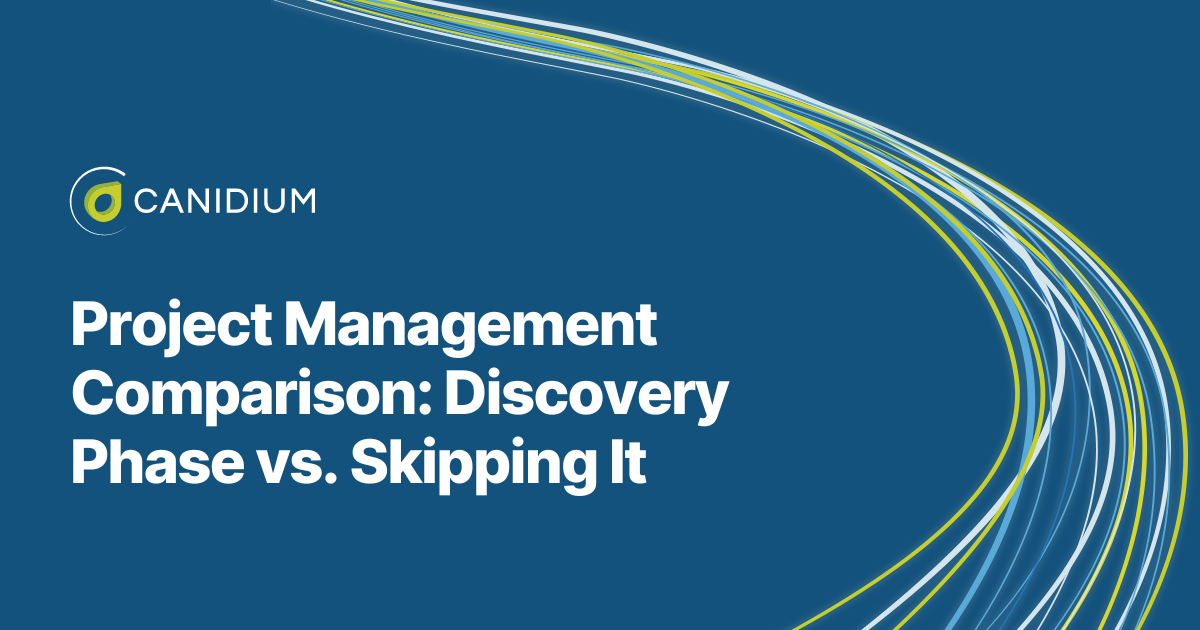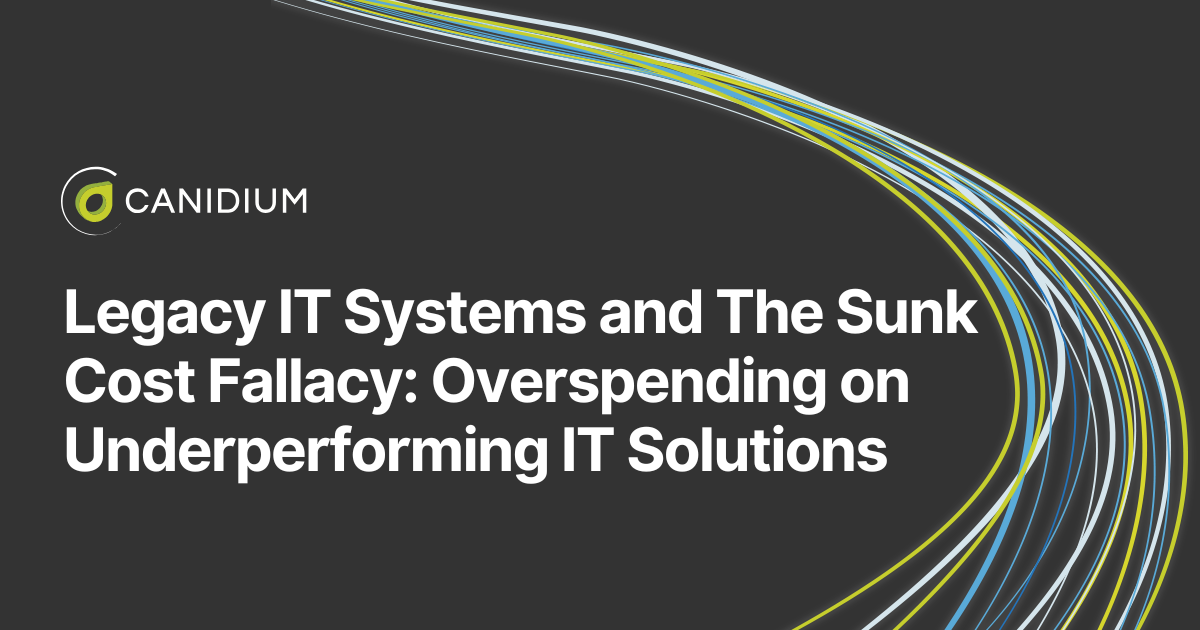Do you need to go through a discovery phase to manage your software project implementation successfully? Unfortunately, this question does not come with a yes or no answer. You must examine your circumstances, goals, and priorities to find the right project management approach.
This process involves weighing the benefits of structured and detailed upfront planning against the advantages of faster project initiation and potentially quicker returns on investment. The problem is further complicated by the need to balance risk mitigation, resource allocation, and stakeholder alignment against your project timelines and budget constraints.
At Canidium, we conduct projects with and without paid discovery phases. Based on this experience, our team of software implementation experts has identified the key deciding factors to consider when determining whether your project needs a discovery session.
To complete your understanding of the topic, we will cover the following:
- What is a discovery phase?
- The pros and cons of discovery sessions
- What is the alternative to a discovery phase?
- The pros and cons of skipping a discovery phase
- When to opt for a discovery session
- When to skip a project discovery phase
What Is a Project Discovery Phase?
A project discovery phase is a preliminary stage in project planning that typically spans four to six weeks. This phase involves conducting on-site and virtual meetings with various potential stakeholders to assess and determine the project's requirements and priorities accurately. The main goal of this phase is to provide a structured framework to uncover essential project details that your internal implementation team has not yet defined or understood.
During your discovery sessions, your implementation partner delves into your needs, strategies, and team goals, which are critical for setting the project's direction. This period allows the project team to gather crucial information, including detailing the project's requirements and expectations.
The in-depth understanding obtained through the discovery phase is vital for the successful planning and execution of many projects, especially when the client's needs and goals are initially unclear or when consensus within the client's organization needs to be built.
Whether or not to include a discovery phase is one of the first decisions you must make before initiating your project with your selected software implementation partner.
.png?width=1920&height=1080&name=Heading%20(8).png)
Benefits of Project Discovery:
- Clarity and Definition of Needs: Discovery sessions help clarify what your team wants. They also allow your implementation partner to better understand your strategies and priorities. This benefit is especially crucial when you may not have a clear picture of what is needed or when internal consensus within your organization is lacking.
- Structured Planning: The four to six-week period allocated for discovery provides a structured approach to planning the project comprehensively. This involves multiple on-site and virtual meetings with different stakeholders, which helps determine the organization's most impactful priorities and requirements.
- Risk Mitigation: By investing time in understanding the project requirements upfront, discovery phases reduce the risk of project failures or misalignments with your expectations. This structured initial phase ensures all parties agree on the project scope and objectives before full-scale execution begins.
- Resource Allocation: This process effectively uses available resources, especially when subject matter experts are only available for a discrete period. Discovery maximizes this time to gather all requirements, setting a solid foundation for the project.
- Suitability for Fixed Fee Projects: For projects where a fixed fee is preferred, discovery is almost essential. It ensures that all requirements are thoroughly understood and agreed upon before the project proceeds, minimizing the risk of misunderstandings, scope changes, and unexpected changes.
Drawbacks to Project Discovery:
- Cost Implication: The main drawback of a discovery is the additional upfront costs. Clients must invest in this discovery phase without immediate tangible results in project progression.
- Time Consumption: While it provides a thorough understanding of the project, discovery also extends the time before the actual project work begins. This could be a disadvantage for projects with tight timelines where speed is essential.
- Resource Intensity: Discovery can be resource-intensive, requiring your team's significant time and personnel involvement. This can be challenging if resources are limited or competing priorities exist.
- Potential Dependency: There's a risk that the project could become locked into the findings and directions set during the discovery phase, potentially limiting flexibility in handling evolving requirements or changes during the project execution phase.
What Is The Alternative to a Discovery Phase?
While 75% of survey respondents reported that their organization carried out discovery phases, only 20% said they do one for every project. A 60% majority of respondents reported that they carried out an average of 1 discovery phase per 2-4 projects. These statistics indicate that carrying out a discovery phase is by no means your only option.
The most straightforward alternative is directly starting the project without the preliminary discovery process. Simply put, you are skipping the four to six-week process of working out the detailed requirements of your project. This approach involves planning the project to be delivered in a more “Agile” way. The project team will still identify their requirements and then the Configuration Engineers will develop the software based on your priorities. Following each development cycle, typically lasting 2-3 weeks, they will demo their completed work to verify that it meets the written requirements, “user stories” in Agile software delivery.
You may also opt for a hybrid project management approach, conducting an upfront discovery phase to gather and lock in all the requirements and then proceeding with the project delivery in an agile fashion, typically using 2-3 week sprints.
This model allows for detailed planning and consensus-building during the initial discovery phase, ensuring all project requirements are precise and agreed upon. Following this, the agile implementation phase provides flexibility, with regular iterations and adjustments as the project progresses, adapting to any changes or new insights that arise.
.png?width=1920&height=1080&name=Heading%20(9).png)
The Benefits of Skipping the Discovery Phase:
- Faster Project Initiation: By bypassing the discovery phase, projects can start immediately, reducing the time to project kickoff and potentially speeding up the overall timeline.
- Quicker ROI: Directly starting the project allows for a faster implementation, leading to quicker realization of benefits and ROI. This factor is especially important for clients looking to see immediate results from their investment.
- Suitability for Agile Projects: Skipping discovery aligns well with agile methodologies, where the project can evolve through continuous iterations and adjustments based on real-time feedback and changes in project requirements.
- Efficiency for Well-Defined Needs: This approach works best for clients with a clear understanding of their project requirements, goals, and organizational alignment to proceed without requiring extensive upfront analysis and consensus-building.
Drawbacks of Skipping the Discovery Phase:
- Risk of Unclear Requirements: Without a discovery phase, there is a higher risk of starting a project with incomplete or misunderstood requirements, which can lead to challenges in project execution and potential misalignments with client expectations.
- Potential for Scope Creep: Projects are more susceptible to scope creep without the thorough upfront planning and stakeholder alignment that discovery provides. Changes and additions to the project scope can occur unpredictably, leading to increased costs and extended timelines.
- Less Stakeholder Buy-In: Discovery often helps build consensus among key stakeholders by involving them in the requirement gathering and planning process. Skipping this phase might result in less buy-in from various stakeholders, affecting the smooth execution and acceptance of the project outcomes.
- Increased Risk of Project Adjustments: Projects that start without a discovery might require more frequent adjustments and revisions as new information and requirements emerge during the project lifecycle. This approach can lead to inefficiencies and additional costs.
When to Opt for a Project Discovery Phase
You should consider opting for a project discovery phase when your project requirements are unclear or if you are uncertain about your needs, strategy, or priorities. This phase is essential for projects where defining and clarifying these aspects is necessary before proceeding. It also facilitates building consensus within your organization, involving various stakeholders in discussions to ensure alignment and support. This benefit is particularly important for complex projects that require detailed planning and a thorough understanding of the requirements upfront.
If your subject matter experts are only available for a short, specific period, a discovery maximizes this time to gather all crucial information, setting a solid foundation for the project. The structured planning approach of the discovery phase also aligns well with the Waterfall methodology, which emphasizes thorough upfront specification and documentation.
When to Skip a Project Discovery Phase
Consider skipping the project discovery phase when you already have a clear and well-defined set of requirements, understand your needs, and know the project goals and objectives very clearly. This allows for the project's immediate commencement and is beneficial for tight timelines where a faster return on investment is desired.
Projects that benefit from flexibility and continuous adaptation, particularly those suitable for Agile methodologies, may proceed without a discovery phase. In Agile projects, the ability to adapt and evolve requirements through iterative development cycles is valued over comprehensive upfront planning, typical of Waterfall approaches.
Additionally, if you face resource constraints—whether in budget or time—directly starting the project can more effectively direct available resources toward achieving critical project milestones without the preliminary expense of discovery.
.png?width=1920&height=1080&name=Heading%20(10).png)
Should You Skip The Project Discovery Phase?
The project discovery phase, typically four to six weeks, involves extensive meetings and consultations to define project needs, gather requirements, and ensure all stakeholders are aligned. This phase is crucial if your project needs are not well-defined or if comprehensive planning and risk mitigation are necessary. The benefits of engaging in a discovery phase include a clear definition of needs, structured planning, effective resource allocation, and suitability for fixed-fee projects. However, it has drawbacks such as additional upfront costs, extended project timelines, and potential dependence on initial findings.
On the other hand, skipping the discovery phase allows for faster project initiation and quicker ROI. This approach suits projects with well-defined requirements and those amenable to Agile methodologies, where flexibility and iterative development are prioritized. Yet, this can increase your risk of unclear requirements, scope creep, reduced stakeholder buy-in, and the need for frequent adjustments during the project.
If you are still deciding between these approaches, consider a discovery phase if your project involves complex requirements or requires broad stakeholder consensus. Alternatively, opt to skip this phase or choose a hybrid approach if your project requirements are straightforward and well-understood and when time or budget constraints prioritize a quicker start.
Once you have determined whether or not you should plan for a discovery session, your next step is to prepare internally for your implementation's start date. Begin by learning how to prepare your data ahead of time.








